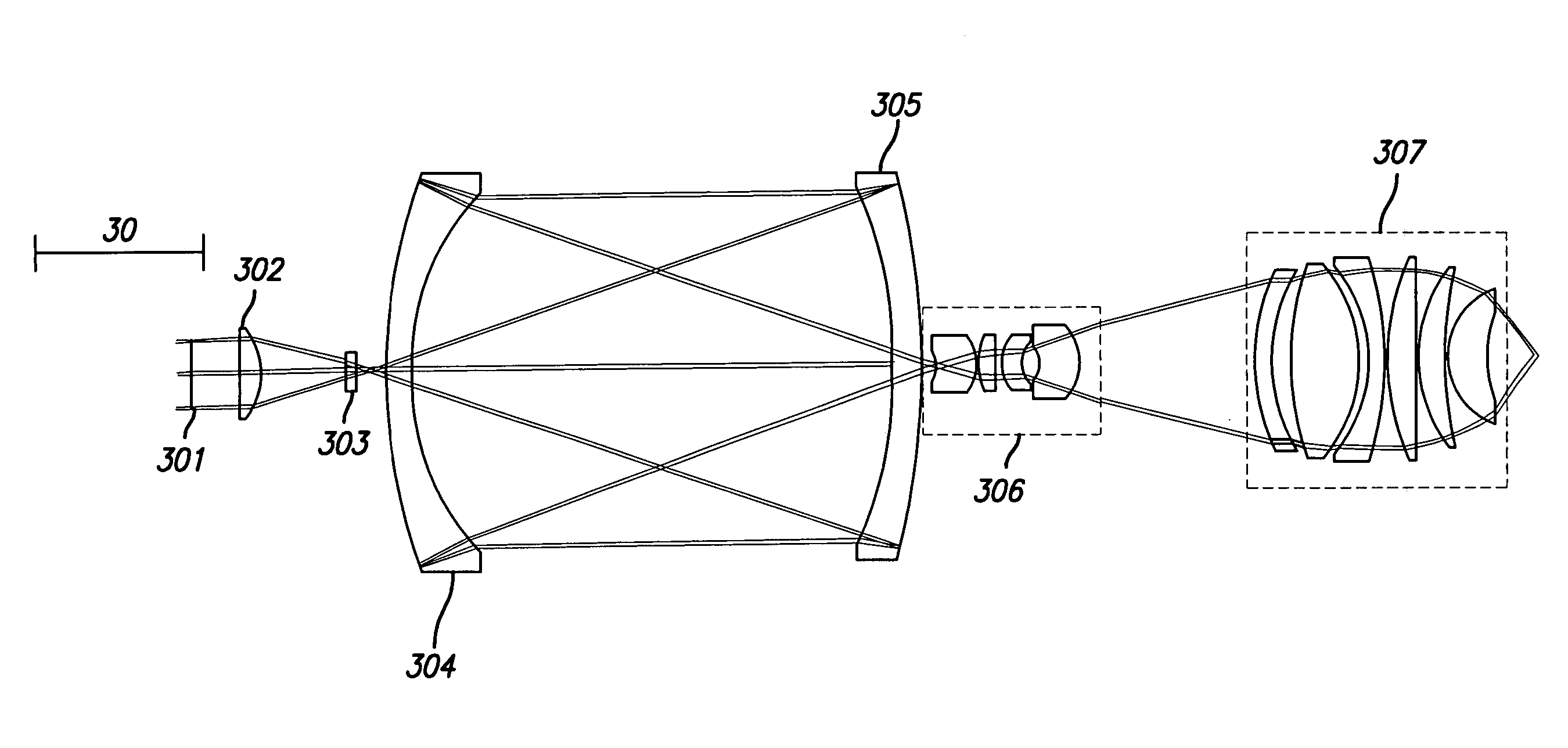Broad band DUV, VUV long-working distance catadioptric imaging system
a long-working distance, optical system technology, applied in the field of optical imaging, can solve the problems of affecting mechanical stability and manufacturing costs, limited working distance, internal pupil, etc., and achieves the effect of minimizing the central obscuration of the system, long free working distance, and small obscuration
- Summary
- Abstract
- Description
- Claims
- Application Information
AI Technical Summary
Benefits of technology
Problems solved by technology
Method used
Image
Examples
first embodiment
[0040] This embodiment has a bandwidth of 1 nm with the central wavelength at 193.30 nm. The numerical aperture is 0.8, while the working distance is greater than 7 millimeters. The central obscuration is less than 5% in diameter at 0.8 NA. Even at 0.35 NA, the central obscuration is still below 16% in diameter, which is equivalent to 2.5% of area obscuration. The surface data for the first embodiment is listed in Table 1.
TABLE 1Surface data of a 193 nm catadioptric designwith a 1 nm bandwidth as shown in FIG. 4Radius ofSurface #curvatureThicknessGlassOBJInfinityInfinityAirSTOInfinity15.188841Air2−81.6279083.5Silica3−18.04068522.449116Air418.744572Silica5795.1375921.998104Air684.9966625Silica740.30242297.532362Air8−78.5674765Silica9−132.110046−5Reflector / Silica10−78.567476−97.532362Air1140.302422−5Silica1284.9966625Reflector / Silica1340.30242297.532362Air14−78.5674765Silica15−132.11004614.180612Air1641.9060432.999944Silica17−19.6453290.499948Air1810.2065346.643053Silica196.3142745.38...
second embodiment
[0050] the current invention is shown in FIG. 5. The design of FIG. 5 is a more complex version of the 193 nm optical design with emphasis on loose tolerances. From FIG. 5, light energy passes pupil plane 501 to first lens 502 and field lens group 503 to mangin mirror 504 and lens 505. Light energy reflects between the mangin mirror 504 and mangin mirror 506 before leaving through the hole in mangin mirror 506. Light then passes through field lens group 507, including first through fourth field lenses 507a through 507d, and focussing lens group 508, including first through sixth focusing lenses 508a through 508f.
[0051] One major difference between the design of FIG. 4 and that of FIG. 5 is the addition of a lens 505 inside the catadioptric cavity. The extra lens 505 enables simple modification of higher-order aberrations and results diminished requirements for the field lens group 507. The resulting field lens group 507 exhibits decreased tolerance sensitivity compared with previou...
third embodiment
[0053] the present invention is a 0.85 NA design for 157 nm and is shown in FIG. 6. From FIG. 6, pupil plane 601 is to the left of first lens 602 and field lens group 603. Light energy passing through first lens 602 and field lens group 603 is directed to mangin mirror 604, lens 605, mangin mirror 606, lens 607, filed lens group 608, and focussing lens group 609. Field lens group 608 comprises first through third lenses 608a through 608c and focussing lens group 609 comprises first through sixth lenses 609a through 609f.
[0054] The field sizes for the 0.85 NA and the 0.386 NA modes of operation are 0.264 mm diameter and 0.58 mm diameter, respectively. A + / −5 microns decenter of any element leaves the on-axis Strehl value above 0.80, and the arrangement shown in FIG. 6 has been optimized for this decentering. Addition of compensation elements provides for variances in manufacturing tolerances without appreciable degradation. The surface data for one example of the type of design pres...
PUM
| Property | Measurement | Unit |
|---|---|---|
| wavelengths | aaaaa | aaaaa |
| wavelengths | aaaaa | aaaaa |
| wavelengths | aaaaa | aaaaa |
Abstract
Description
Claims
Application Information
 Login to View More
Login to View More - R&D
- Intellectual Property
- Life Sciences
- Materials
- Tech Scout
- Unparalleled Data Quality
- Higher Quality Content
- 60% Fewer Hallucinations
Browse by: Latest US Patents, China's latest patents, Technical Efficacy Thesaurus, Application Domain, Technology Topic, Popular Technical Reports.
© 2025 PatSnap. All rights reserved.Legal|Privacy policy|Modern Slavery Act Transparency Statement|Sitemap|About US| Contact US: help@patsnap.com



